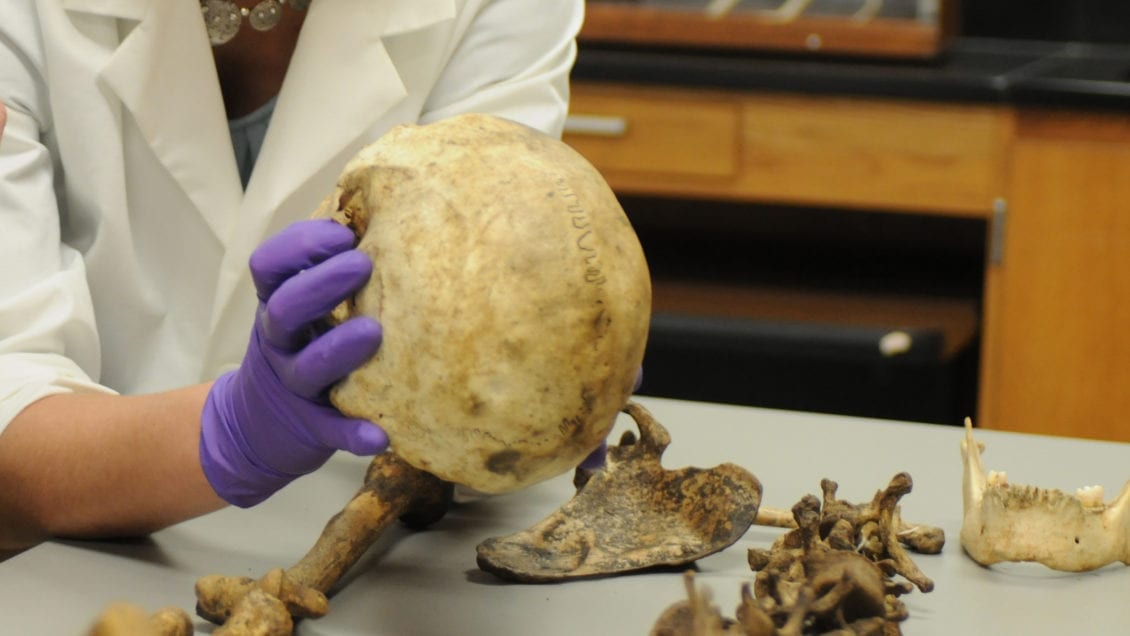Smartphone apps usually define success by the amount of people actively using them, but a new app created by a Clemson researcher must also gauge its success on dead bodies. Katherine Weisensee, the chair of Clemson’s sociology, anthropology and criminal justice department whose research has informed the app’s development, said a few million photos of roadkill won’t hurt either.
The app, dubbed geoFOR, allows coroners and forensic teams to enter observations when human remains are recovered and then upload photos along with accompanying information related to variables such as geography and crime scene data. The goal, Weisensee said, is to capture as much information on body decomposition as possible across a variety of geographic areas.

Ideally, after years of use, the app will have captured enough data on body decomposition from a large enough collection of locations globally to provide a near-instant estimate of time of death.
“People get the wrong idea of how professionals determine time of death from shows like ‘CSI,’” Weisensee said. “It’s actually extremely difficult, and it often comes down to the level of experience of a forensic investigator. The decomposition process is highly complex and influenced by a wide range of factors that depend on an individual and the environment in which they die.”
Weisensee said a person need only look at the current, standard categories of decomposition to see how lacking they are to describe such a complex process. There are only four: fresh, active decomposition, starting to skeletonize and completely skeletonized. These artificial stages haven’t been widely tested or modeled, and little research has been dedicated to systematically evaluate variables that make up each stage.
Numerous factors contribute to decomposition, such as temperature, humidity, elevation, and proximity to bodies of water, to name a few. “Body farms,” which are dedicated areas for the study of decomposition, exist only in a few locations most notably Tennessee and Texas in the U.S. These specific sites can’t account for what can occur with a body in Montana during a freeze/thaw cycle or one found near the Pacific Ocean.
The app prompts users to input information about the scene, such as clothing, location, insect access, scavengers and apparent trauma; alongside data on decomposition stage and gender, age, and body type. The app then automatically factors in information from numerous geographical and environmental databases in order to start building a database on how these specific variables observed on the body overlap with geography and environmental factors.

“This project will also help forensic teams move toward standardizing the variables they collect,” Weisensee said. “Bodies don’t move through these stages in a standardized way, so systematically inputting data across every different imaginable environment will allow us to create more robust models to determine time of death.”
Weisensee worked with the Clemson University Center for Geospatial Technologies to develop the app, which is funded by the Forensic Sciences Foundation Lucas Research Grant. It is currently being beta tested by multiple South Carolina coroners, and Weisensee has applied for additional funding to disseminate the app to more users. She hopes that features such as an automatic temperature calculator factored in on site that can approximate an initial, rough time-of-death estimate will bring more users to the app.
The other challenge in design is the lack of human remains available, according to Weisensee. She is planning a public version of the app that will allow anyone encountering animal remains, such as roadkill or those found by hikers in wooded areas, to snap a photo and input information to add to the database.
“That information will be just as valuable, and of course it’s easier to find animal bodies,” Weisensee said. “From soil and weather databases to the actual human and animal remains, the data is all out there; we’ve just got to start collecting it.”
Weisensee is no stranger to the study of human decomposition. She earned a Ph.D. and a master’s degree in anthropology from the University of Tennessee, and she spent a significant amount of time studying body decomposition on the campus’s body farm. She is also often consulted by law enforcement agencies who find corpses that are well past the final stage of skeletonization.
Her insights into the condition of skeletons has been instrumental for law enforcement in determining time and cause of death in bodies that have long since decomposed. She said the first question across all these consultations is usually related to time of death, so she’s motivated to get this application in the hands of law enforcement, humanitarian agencies and members of the general public with a strong stomach in order to start answering that question automatically.
“It’s exciting to see just how geospatial information meets forensic science, and how all of this information can be combined to finally start quickly answering a question that has eluded people for so long,” Weisensee said.
END
Get in touch and we will connect you with the author or another expert.
Or email us at news@clemson.edu

